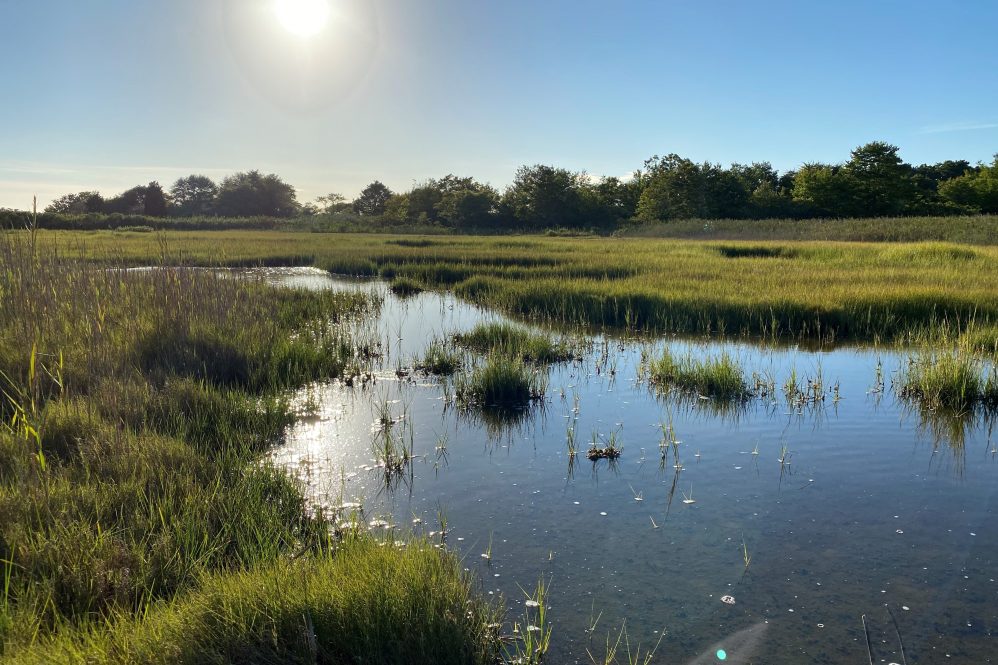Coastal wetlands are one of the most unique and important parts of Connecticut’s landscape. They play an important ecological and economic role. A barrier against storms and flooding, natural filtration for water, an important support for fisheries, and one of the largest carbon sinks on the planet – these are all critical functions of coastal wetlands.
Carbon sinks are reservoirs, natural or otherwise, that accumulate and store carbon. Given that climate change is in large part fueled by carbon emissions from human activity, protecting coastal wetlands is quickly becoming a global priority.
Tidal marsh grasses make for particularly good carbon sinks because they can very effectively trap sediment, and organic matter decomposes very slowly in wetlands’ anoxic sediment. Coastal wetlands’ carbon accumulation rates are 100 times greater than terrestrial forests.
Beth Lawrence, assistant professor of Natural Resources and the Environment in the College of Agriculture, Health, and Natural Resources, has received a Research Excellence Program (REP) grant to address how sea level rise and coastal development may alter the stability of stored carbon. Together with her PhD student, Madeleine Meadows-McDonnell, she is implementing a manipulative experiment to understand the role of plants in regulating soil carbon in coastal wetlands.
The Office of the Vice President for Research REP provides seed funding to fuel innovative research, scholarship, and creative projects.
These changes to coastal wetlands are altering what kinds of plants can live in these marshes, which might affect how well they are trapping and storing carbon.
In areas affected by sea level rise, plants that do well with frequent flooding, such as the native Spartina alterniflora grass, are becoming more prevalent. On the other hand, development along the coast is cutting wetlands off from the ocean with physical barriers such as roads or bridges. In these areas, invasive grass species like Phragmites australis are displacing native species.
Plants play a direct role in carbon capture by influencing the activity of microbes in the soil and levels of soil oxygenation. Lawrence’s lab recently found that organic matter decomposes faster in invasive Phragmites than native Spartina soil, suggesting that plants differentially alter the environmental conditions that determine carbon storage efficiency.
One potential explanation for this difference is that plants release sugars from their roots (i.e., “root exudates”) which stimulate the microbes responsible for decomposition. More active microbes utilize the organic matter in the soil more rapidly, thus, it is a less-effective carbon reservoir. Wetland plants also release oxygen from their roots, which can also promote microbial activity.
Lawrence hypothesizes that adding high-quality soil carbon, such as the kind Phragmites produce, and oxygen will increase the rate of organic material mineralization, or decomposition.
“While increased release of sugars and oxygen by plant roots may stimulate microbial breakdown of soil organic matter and promote carbon dioxide release in the short term, the by-products of microbial metabolism may help lock away soil carbon that will be preserved at longer time scales,” says Lawrence.
Lawrence will use a novel method to measure the microbial activity in these wetlands – sugar. Cane sugar and beet sugar have different isotopic signatures; Lawrence and Meadows-McDonnell are experimentally adding sugars to mimic root exudation and will measure the carbon isotopes in the gas released by the microbes. This method is a low-cost and non-toxic way to track carbon in microbial metabolites. They will also measure organic matter mineralization and aggregate stability, measures of how well the marshes are capturing and storing carbon.
This research will determine how different plants alter how long organic material persists in coastal wetland soil.
This knowledge will help scientists better manage this critical natural resource by understanding how common plant species found along the northeastern U.S. coastline alter the stability of soil carbon.
Follow UConn CAHNR on social media



